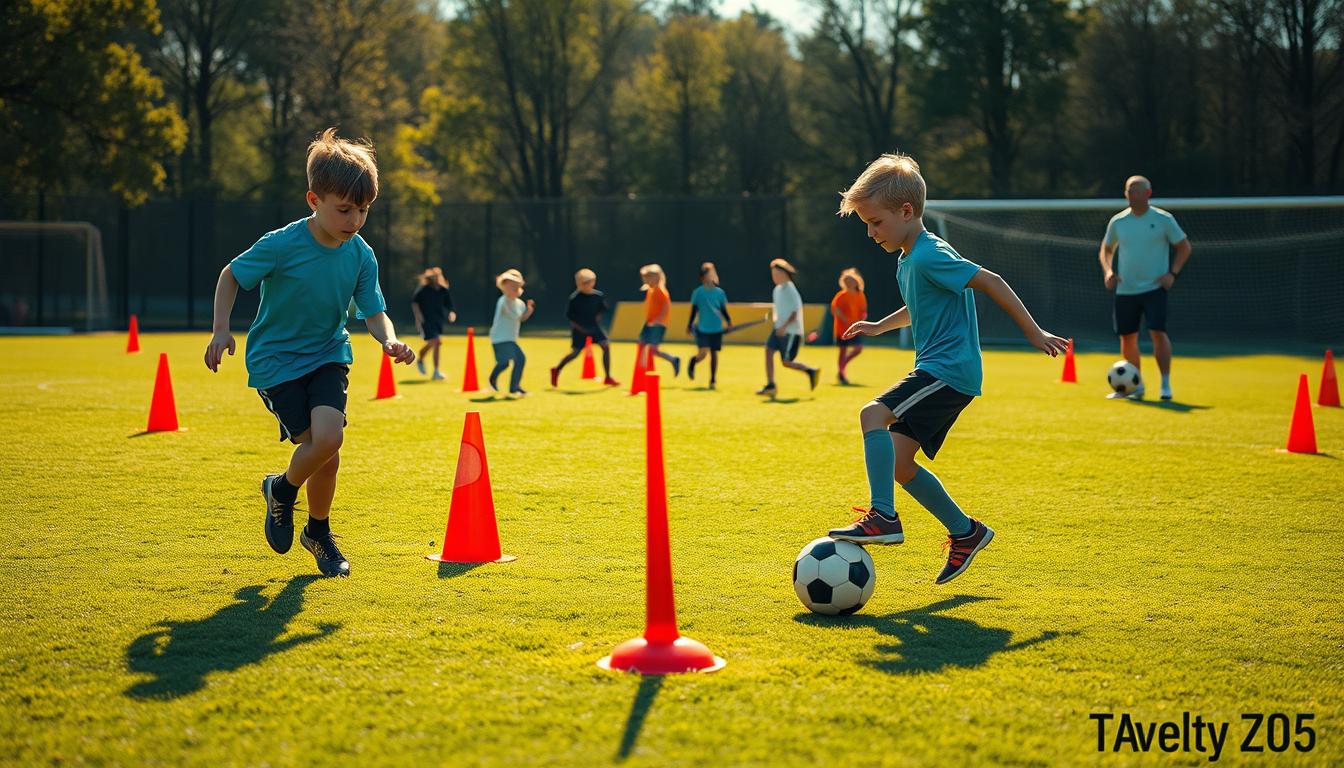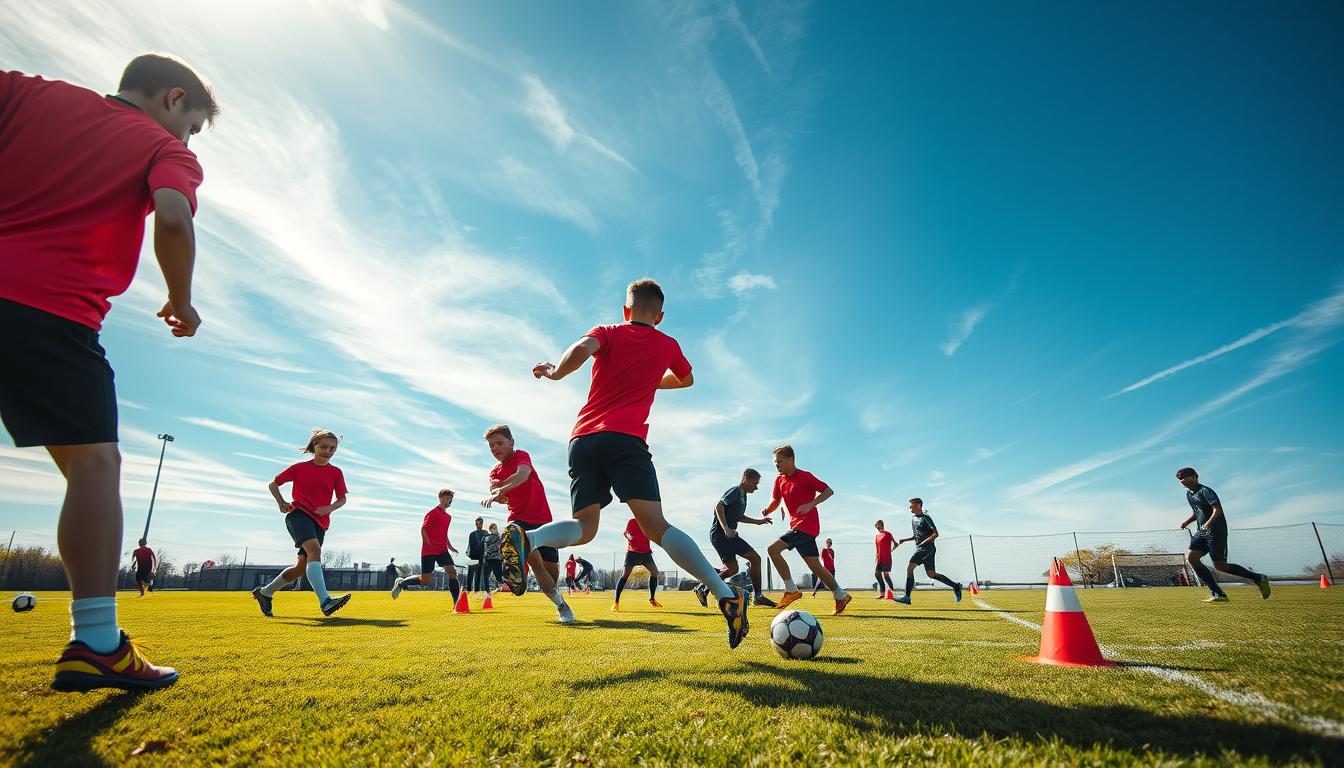Agility Training Plans for Kids Soccer

Imagine your child weaving through defenders like Neymar Jr., effortlessly changing direction to outplay opponents. That level of quick movement isn’t just talent—it’s built through smart, focused routines. For young athletes, mastering agility early can transform how they move, react, and dominate on the field.
This guide breaks down proven methods to boost coordination and speed, inspired by pros who prioritize these skills. You’ll discover drills that build footwork precision, exercises to sharpen reflexes, and strategies to make practice fun. Whether your child is just starting or aiming to compete, these techniques create a foundation for long-term growth.
Key Takeaways
- Agility is the secret weapon for outmaneuvering opponents and enhancing game-day confidence.
- Structured routines help young athletes develop balance, speed, and spatial awareness.
- Proven drills used by elite players can be adapted for any age or skill level.
- Consistent practice leads to noticeable improvements in just weeks.
- Upcoming sections will detail step-by-step exercises and how to track progress.
Understanding Agility in Soccer
Picture a player darting past opponents, pivoting on a dime to seize control of the ball. This skill isn’t luck—it’s built through deliberate practice. Let’s break down what makes this possible.
What Is Agility?
Agility means shifting direction swiftly while keeping your body stable. It combines coordination, control, and quick thinking. Think of it as moving like water—flowing around obstacles without losing speed.
Why Agility Matters for Young Players
Young athletes need to master these skills early. Better movement helps them react faster, avoid collisions, and stay balanced during plays. For example, setting up cones to practice sharp turns teaches how to change direction without stumbling.
Pros like Lionel Messi use similar drills to stay unpredictable. Studies show players with refined agility score 23% more often in tight spaces. Here’s how basic exercises compare:
| Drill Type | Equipment Needed | Key Benefit |
|---|---|---|
| Cone Weave | 5 Cones | Sharpens direction changes |
| Ladder Runs | Agility Ladder | Boosts foot speed |
| Hurdle Hops | 6-inch Hurdles | Improves explosive power |
Consistent practice builds muscle memory. Over time, this leads to smoother movements and better game decisions. Start simple, then increase difficulty as skills grow.
Key Elements of Soccer Speed and Agility
Think of a player exploding past a defender, then stopping instantly to redirect the ball. This blend of quick bursts and sharp stops relies on three core skills: balance, coordination, and precise body control. Let’s explore how these pieces work together.
Muscle Coordination and Balance
Better movement starts with syncing your muscles. For example, single-leg balance drills teach your body to stabilize during rapid shifts. Try this:
- Stand on one leg while lightly tossing a ball
- Hold for 20 seconds, then switch sides
This builds ankle strength and core stability. On the field, this translates to staying upright during tackles or sudden turns.
Acceleration and Deceleration Techniques
Quick starts and stops separate good players from great ones. Practice short sprints with abrupt halts:
- Mark two lines 10 yards apart
- Sprint full speed to the far line
- Stop completely within two steps
Focus on bending your knees and leaning forward slightly. This posture helps you explode forward while keeping control.
Drills like zig-zag runs between cones also sharpen direction changes. Pair these with recovery walks to build endurance. Over time, your body learns to handle speed shifts smoothly.
Soccer Agility Training Plans: Drills and Exercises
Picture a young athlete darting through obstacles with precision, feet moving like clockwork. Effective routines focus on sharpening specific skills through structured repetition. Let’s explore practical methods to elevate performance using basic tools.
Variety of Drills for Different Skills
Mix these exercises into weekly sessions to target coordination and reaction time:
| Drill | Equipment | Focus Area |
|---|---|---|
| Quick-Step Ladder | Flat ladder | Fast foot placement |
| Zig-Zag Cones | 5 cones | Sharp directional shifts |
| Hurdle Hops | Low hurdles | Explosive leg power |
Start with the ladder: run through each box, lifting knees high. Time yourself and aim for smoother steps each round. For cone drills, arrange markers in a zig-zag pattern 3 feet apart. Weave through them while keeping the ball close—this builds control during turns.
Adjust difficulty by spacing hurdles wider or adding footwork challenges like one-touch passes mid-drill. Beginners can slow the pace, while advanced players might race against a timer.
Consistency matters most. Three 20-minute sessions weekly yield better results than one long practice. Track progress by noting how quickly you complete each exercise without losing form. Small improvements add up fast!
Essential Drills for Changing Direction and Body Control
Envision a player reacting instantly to a defender’s fake, hips pivoting to redirect momentum mid-stride. These rapid adjustments require targeted exercises that build both physical control and mental reflexes. Below are two foundational routines to sharpen these skills.

Sprint Backpedal Turn Drill Overview
This exercise mimics evading opponents while tracking the ball. Here’s how to set it up:
- Place two cones 10 yards apart in a straight line
- Sprint forward to the first cone
- Backpedal quickly to the starting point
- Immediately turn 180 degrees and sprint to the second cone
Focus on keeping your knees bent and chest low during turns. This teaches your body to change direction without losing speed. Repeat 5 times per session, gradually reducing hesitation between movements.
Four Cone Drill for Quick Direction Changes
Arrange four markers in a square, each spaced 5 yards apart. Follow this pattern:
- Start at the first cone, sprint diagonally to the third
- Shuffle sideways to the fourth
- Backpedal to the second
- Finish with a forward sprint through the starting point
Keep your eyes up and arms relaxed to maintain body control during transitions. For added challenge, time each loop and aim to beat your record by 1-2 seconds weekly.
Both drills improve how players handle unexpected pressure during games. Completing the full course 3-4 times per week builds muscle memory for sharper cuts and quicker recoveries. Track progress by noting how smoothly you navigate each turn over time.
Using Equipment: Cones, Ladder, and Hurdles
Proper gear transforms basic drills into game-changing workouts. Cones, ladders, and hurdles help young athletes refine their movements with precision. Let’s explore how to maximize these tools for sharper performance.
Agility Ladder Drills for Quick Feet
Ladders teach precise foot placement. Lay it flat on grass or turf, spacing rungs 18 inches apart. Try the “in-and-out” drill:
| Drill | Steps | Focus |
|---|---|---|
| Single-Foot Hop | Hop through each box on one leg | Balance & rhythm |
| Lateral Shuffle | Side-step through ladder, feet never crossing | Hip flexibility |
| Ickey Shuffle | Alternate feet in-out of each rung | Coordination |
Start slow, then speed up as confidence grows. Aim for light, quick steps—like tapping hot pavement. Three 10-minute sessions weekly build muscle memory.
Cone Weave and Hurdle Exercises
Set five cones in a straight line, 2 feet apart. Weave through them using only the outside of your feet to push off. This mimics dodging defenders while keeping the ball close.
- For hurdles: Place six 6-inch barriers 3 yards apart
- Hop over each, landing softly on the balls of your feet
- Keep knees bent to absorb impact
Adjust spacing based on skill level. Wider gaps challenge sprint speed, while closer setups improve rapid direction shifts. Always face forward—your hips should pivot naturally.
Consistency is key. Track progress by timing how fast you complete each drill without knocking over cones or hurdles. Small weekly improvements lead to big game-day results!
Enhancing Performance Through Practice and Recovery
Your young athlete’s ability to bounce back after intense drills determines how quickly they grow. Smart routines before and after sessions protect their energy levels while building long-term stamina. Let’s explore how to balance effort with recovery for steady progress.
Effective Warm-Up and Cool-Down Routines
Start with dynamic stretches to wake up muscles. Arm circles, leg swings, and light jogging prepare joints for quick turns. Spend 8-10 minutes here—rushing increases injury risks.
After drills, switch to static stretches. Hold each position 15-20 seconds to ease tension. Foam rolling calves and quads boosts blood flow, speeding up repair.
| Activity | Time | Benefit |
|---|---|---|
| High-Knee Skips | 3 minutes | Activates hip flexors |
| Side Lunges | 2 sets of 10 | Improves lateral mobility |
| Cool-Down Walk | 5 minutes | Lowers heart rate gradually |
Rest between drill sets matters just as much as effort. For every 5 minutes of intense work, take 90 seconds to breathe deeply. This keeps focus sharp without overloading muscles.
Keep sessions under 45 minutes for players under 12. Focus on technique over speed—proper form prevents strains. Pair these habits with small-sided games to apply skills in realistic scenarios safely.
Consistent recovery routines help athletes train harder, longer. Track rest days to ensure they recharge fully. Small tweaks today lead to big leaps tomorrow!
Integrating Agility Drills into Game Scenarios
Ever watched a player receive a pass under pressure, then instantly pivot to create space? That’s where practice meets real-game magic. Translating drills to live action requires blending structured exercises with unpredictable, fast-paced situations.
From Practice to Play: Bridging the Gap
Start by adding a ball to familiar drills. For example, set up three cones in a triangle. Weave through them while controlling the ball with quick touches. This builds coordination needed to dodge defenders while keeping possession.
Next, introduce decision-making challenges. Have a partner call out directions mid-drill—like “left” or “spin”—forcing you to react without hesitation. Studies show players who train under simulated pressure make choices 40% faster during matches.
Try this game-like routine:
- Place five cones randomly across 10 yards
- Dribble through them while a defender applies light pressure
- Focus on sharp cuts and keeping your head up
These exercises teach your body to handle surprises. You’ll learn to shift weight smoothly and maintain quickness even when tired. Track improvements by counting successful escapes during scrimmages.
Remember: The best players don’t just practice moves—they prepare for chaos. Mix drills with live play weekly to see real-game results!
Final Insights for Building Agility on the Field
Mastering sharp turns and rapid reactions starts with smart preparation. Those quick direction changes you see elite players make? They’re built through precise cone drills, ladder patterns, and hurdle setups spaced at the right distances. Proper line markings and course layouts matter—they teach your body to navigate tight spaces instinctively.
Focus on control in every movement. Whether weaving through markers or practicing footwork, clean technique beats raw speed. Studies show athletes who prioritize balanced movements reduce missteps by 34% during games. Start with shorter distance drills, then expand as skills grow.
Consistency transforms practice into muscle memory. Three weekly sessions of 20 minutes yield better results than marathon workouts. Track progress by timing how fast you complete a field circuit without sacrificing form.
Ready to level up? Integrate these routines into your team’s warm-ups. Pair them with recovery stretches to maintain peak performance. Remember: Great players aren’t born—they’re built through focused repetition and smart adjustments. Your next breakthrough begins with the first step.
